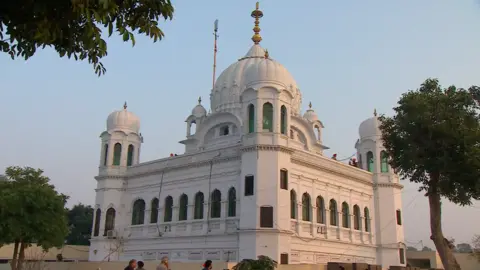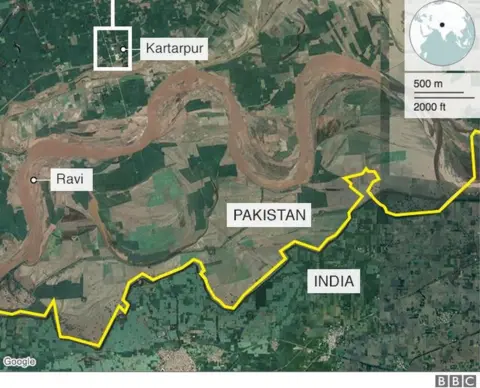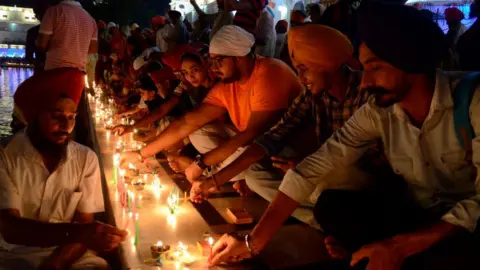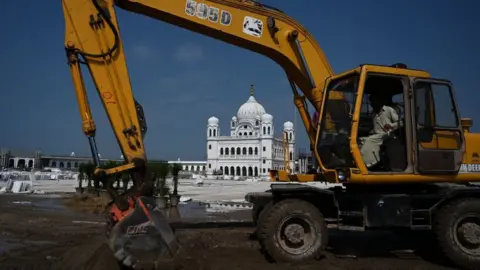Kartarpur corridor: India and Pakistan sign deal on Sikh temple project
 BBC
BBCIndia and Pakistan have signed a deal that will allow pilgrims from India to visit one of Sikhism's holiest shrines in Pakistan without a visa.
The Kartarpur corridor is a new entry point giving access to the Gurdwara Darbar Sahib Kartarpur in Punjab.
Tensions between the two countries have often made it hard to access and this is being seen as rare cooperation.
Sikhism was born in Punjab, a region that was divided during the partition of British India in 1947.
Indian and Pakistani officials signed the agreement at Zero Point, the international border between the two countries.
The temple, located some 4km (2.5 miles) from the border with India, is believed to have been built on the site where Guru Nanak, the founder of Sikhism, died in the 16th Century.
Earlier in the week, Pakistani Prime Minister Imran Khan claimed it was the "world's largest gurdwara", adding that the country would open its doors to Sikhs from across the world.
The corridor, which will be open to the public on 10 November, leads from the border straight to the gurdwara.
But finalising details about the corridor hasn't been easy, resulting in a protracted process that has dragged on since it was first announced almost a year ago.
What do we know so far about the corridor?
It is in the last stages of construction and officials have said that it will be open for use by early November.
Hundreds of labourers are still busy putting finishing touches to the gurdwara and its expansion, which is spread across 42 acres.
The corridor will also feature a bridge that will allow visitors to cross over the Ravi river, which flows between the international border and the shrine.

Construction of new amenities surrounding the temple began soon after the project was officially announced in November last year.
The expansion includes a new courtyard, museum, library, dormitories, locker rooms, an immigration centre and an embankment to protect the temple in case of floods.
While Indian pilgrims do not need a passport or a visa for Pakistan, they will still need to obtain a permit before they go.
All the details about the process haven't been released by officials yet, but we know that visitors must apply online for a permit, which will then need to be approved by both India and Pakistan.
Why did it take so long to strike a deal?
The Sikh community in India has long demanded access to the corridor. Previous Indian governments even began preliminary discussions with Pakistan over access to the shrine.
It was first discussed in 1998 and then again in 2004 and 2008, but these talks never led to anything concrete.
Since partition, Indians have had limited access to the shrine, often struggling to obtain visas to visit, says BBC Punjabi's Dalip Kumar.
 Getty Images
Getty ImagesA historically tense relationship between India and Pakistan - who have fought three wars since 1947 - has made it difficult for a deal to be made.
Correspondents say the project signals a thaw in relations, although tensions between the nuclear-armed neighbours have soared this year.
In February, India launched air strikes against militants in Pakistani territory in response to a suicide attack in Kashmir which killed 40 Indian soldiers. The Pakistan-based Jaish-e-Mohammad (JeM) group said it had carried out that attack.
In August, India stripped the part of Kashmir it administers of its partial autonomy, sparking sharp criticism from Pakistan. Since then Pakistani Prime Minister Imran Khan has been lobbying for international support against the move, which he has described as "illegal".
Delhi and Islamabad both claim Kashmir in full, but control only parts of it.
The signing of the Kartarpur deal itself was delayed by a day, with officials citing "logistical issues". On Monday, India said it was "disappointed" with Islamabad for insisting on charging pilgrims a $20 (£15) service fee to cross the border - but then said it would still go ahead and sign the deal.
What is the significance of the shrine?
The present shrine was built in 1925 after the original one was destroyed by floods.
This was later restored by the Pakistani government in 2004.
The shrine was built to commemorate the site where Guru Nanak spent the last 18 years of his life.
It is considered to be the second holiest site for Sikhism after Gurdwara Janam Asthan in Pakistan, which was built at the site where Guru Nanak was born.
What happens next?
Pakistan is set to open the corridor early next month, just in time for the 550th birth anniversary of Guru Nanak on 12 November. Devotees from all over the world, including the UK and Canada, are expected to visit for the celebrations.
 Getty Images
Getty ImagesIt is not yet clear when registration for the permits will open, but many Sikh pilgrims in India have been waiting to visit the shrine for years.
Officials have said that the corridor will be able to accommodate up to 5,000 pilgrims per day, and up to 10,000 will be able to visit the shrine every day.
Analysts have said that the Kartarpur border crossing is a significant development and an instance of rare cooperation between the two countries - but they have also said that it would be wrong to suggest that what lies ahead is a peace process.
They describe it as a confidence building measure but point out that at the end of the day, India and Pakistan are still at loggerheads.
